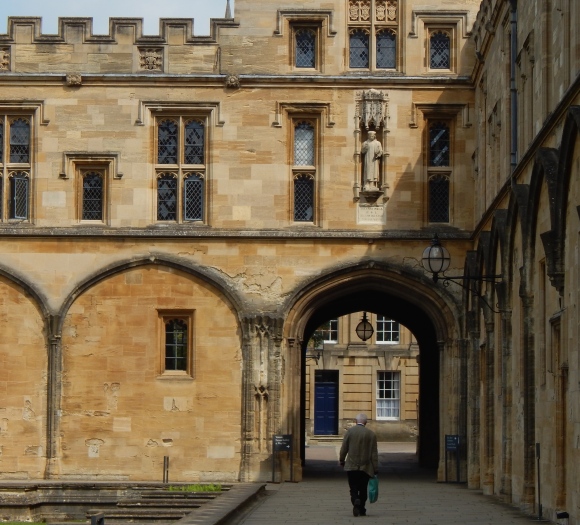 I spent most of my last full day here in Oxford just wandering around looking at the town, since it is highly amenable to drifting, and everything shuts down by mid-afternoon anyhow. Like Venice (and not too many other places), Oxford seems like an impossibly pretty place to have survived into the present century. And unlike Venice, Oxford is not sinking under the weight of the zillions of tourists who have ruined it for natives (if, indeed, there are any real Venetians left). It seems to have adapted just fine, thank you very much, into the present while still fulfilling its primary mission, and being very, very pretty while doing it (allowing for the occasional and unfortunate stab at “modernity” that took the form of Brutalist dormitories, and the “Haunted Oxford” tours, for which there is no excuse). So how did that happen in this rarefied place? I often mull on an observation from an editorial on the demolition of Penn Station, in which the writer recorded the damning statement: we get the cities we deserve. It helps me understand the dreadful state of so many cities that have been shaped by short-sighted politicians, for cheapness (not economy, but cheapness),and crude concerns for alleged personal conveniences. But I have trouble understanding that sentiment in light of Oxford. Does anyone really deserve all of this? And don’t more of us deserve better?
I spent most of my last full day here in Oxford just wandering around looking at the town, since it is highly amenable to drifting, and everything shuts down by mid-afternoon anyhow. Like Venice (and not too many other places), Oxford seems like an impossibly pretty place to have survived into the present century. And unlike Venice, Oxford is not sinking under the weight of the zillions of tourists who have ruined it for natives (if, indeed, there are any real Venetians left). It seems to have adapted just fine, thank you very much, into the present while still fulfilling its primary mission, and being very, very pretty while doing it (allowing for the occasional and unfortunate stab at “modernity” that took the form of Brutalist dormitories, and the “Haunted Oxford” tours, for which there is no excuse). So how did that happen in this rarefied place? I often mull on an observation from an editorial on the demolition of Penn Station, in which the writer recorded the damning statement: we get the cities we deserve. It helps me understand the dreadful state of so many cities that have been shaped by short-sighted politicians, for cheapness (not economy, but cheapness),and crude concerns for alleged personal conveniences. But I have trouble understanding that sentiment in light of Oxford. Does anyone really deserve all of this? And don’t more of us deserve better?
Postcards from Sabbatical-land
430 days, 100s of buildings, innumerable pages, dozens of libraries, a few extra-curriculars, 1 canine copilot
Tag Archives: Oxford
The Afterlife of Sir Christopher Wren
Today I engaged in the most businessy business of my English sojourn by presenting a paper at a conference, sponsored by the Society of Architectural Historians of Great Britain at St. John’s College, Oxford, on Wren’s later life/influence/rejection following his death. My paper considered what I called Wren’s inexorable influence: he was too big, too famous, too extraordinary to ignore, and yet too problematic ( for 19th- century Americans, at least) to embrace whole-heartedly. My architect, Walter, found his way around Wren by focusing on the rational and ” scientific” aspects of his practice (especially the dome of St. Paul’s), and he wasn’t alone. Wren was alternately revered, reviled, totemized and trumped as a model of aesthetics, science, practice, at home and abroad. In addition to this fine consideration of a great architect, the symposium made me wonder more generally on the nature of fame. Are there other architects of Wren’s long- lasting, yet changing status? Are their stories similarly tied to themes of colonialism and empire? Does that key into the way their appreciation alters through time? And to what extent, if any, do monumental people rise above, or fall below, the fame of the monuments that they leave behind? I wonder.
